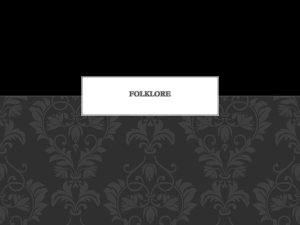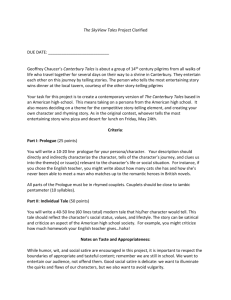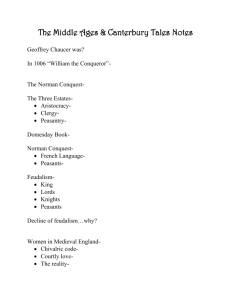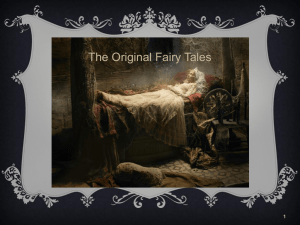Uncloaked - Seattle Central College
advertisement
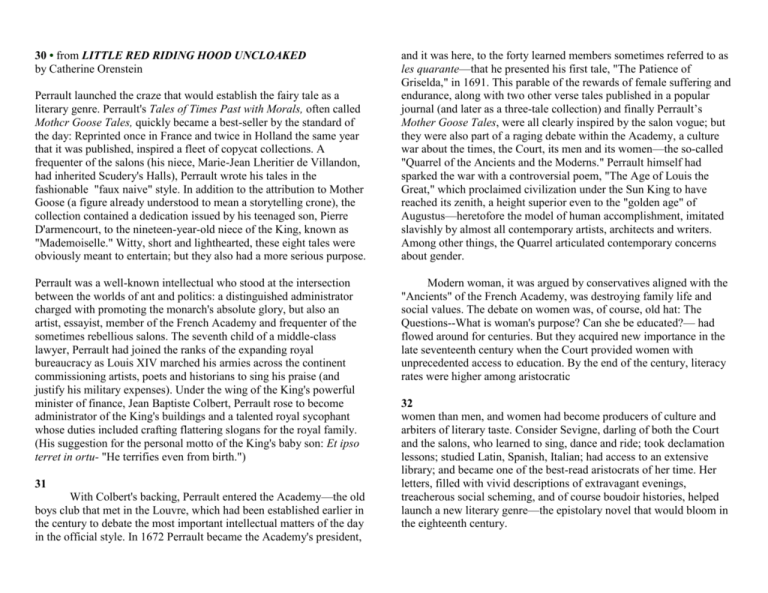
30 • from LITTLE RED RIDING HOOD UNCLOAKED by Catherine Orenstein Perrault launched the craze that would establish the fairy tale as a literary genre. Perrault's Tales of Times Past with Morals, often called Mothcr Goose Tales, quickly became a best-seller by the standard of the day: Reprinted once in France and twice in Holland the same year that it was published, inspired a fleet of copycat collections. A frequenter of the salons (his niece, Marie-Jean Lheritier de Villandon, had inherited Scudery's Halls), Perrault wrote his tales in the fashionable "faux naive" style. In addition to the attribution to Mother Goose (a figure already understood to mean a storytelling crone), the collection contained a dedication issued by his teenaged son, Pierre D'armencourt, to the nineteen-year-old niece of the King, known as "Mademoiselle." Witty, short and lighthearted, these eight tales were obviously meant to entertain; but they also had a more serious purpose. Perrault was a well-known intellectual who stood at the intersection between the worlds of ant and politics: a distinguished administrator charged with promoting the monarch's absolute glory, but also an artist, essayist, member of the French Academy and frequenter of the sometimes rebellious salons. The seventh child of a middle-class lawyer, Perrault had joined the ranks of the expanding royal bureaucracy as Louis XIV marched his armies across the continent commissioning artists, poets and historians to sing his praise (and justify his military expenses). Under the wing of the King's powerful minister of finance, Jean Baptiste Colbert, Perrault rose to become administrator of the King's buildings and a talented royal sycophant whose duties included crafting flattering slogans for the royal family. (His suggestion for the personal motto of the King's baby son: Et ipso terret in ortu- "He terrifies even from birth.") 31 With Colbert's backing, Perrault entered the Academy—the old boys club that met in the Louvre, which had been established earlier in the century to debate the most important intellectual matters of the day in the official style. In 1672 Perrault became the Academy's president, and it was here, to the forty learned members sometimes referred to as les quarante—that he presented his first tale, "The Patience of Griselda," in 1691. This parable of the rewards of female suffering and endurance, along with two other verse tales published in a popular journal (and later as a three-tale collection) and finally Perrault’s Mother Goose Tales, were all clearly inspired by the salon vogue; but they were also part of a raging debate within the Academy, a culture war about the times, the Court, its men and its women—the so-called "Quarrel of the Ancients and the Moderns." Perrault himself had sparked the war with a controversial poem, "The Age of Louis the Great," which proclaimed civilization under the Sun King to have reached its zenith, a height superior even to the "golden age" of Augustus—heretofore the model of human accomplishment, imitated slavishly by almost all contemporary artists, architects and writers. Among other things, the Quarrel articulated contemporary concerns about gender. Modern woman, it was argued by conservatives aligned with the "Ancients" of the French Academy, was destroying family life and social values. The debate on women was, of course, old hat: The Questions--What is woman's purpose? Can she be educated?— had flowed around for centuries. But they acquired new importance in the late seventeenth century when the Court provided women with unprecedented access to education. By the end of the century, literacy rates were higher among aristocratic 32 women than men, and women had become producers of culture and arbiters of literary taste. Consider Sevigne, darling of both the Court and the salons, who learned to sing, dance and ride; took declamation lessons; studied Latin, Spanish, Italian; had access to an extensive library; and became one of the best-read aristocrats of her time. Her letters, filled with vivid descriptions of extravagant evenings, treacherous social scheming, and of course boudoir histories, helped launch a new literary genre—the epistolary novel that would bloom in the eighteenth century. Salon life also provoked controvers. The salons fostered feminism, before the existence of that term. Some of the prominent bluestockings fought for legal reforms to give women the right to marry or remain single, to refuse to have children, and to look after their own affairs -and later in the century, their fairy tales, when eventually published, would express these struggles. The salon hostesses were also so powerful that the approval of certain among them was the unofficial prerequisite for election to the French Academy. But while they were centers of progress, the salons were also targets of derision and ridicule. Conservatives cast them as elegant brothels and decried the mixing ot classes and sexes. The seventeenth-century French moralist Jean de la Bruyere compared an educated woman with a collector's special firearm, "which one shows to the curious, but which has no use at all, any more than a carousel horse.” The playwright Moliere mocked the salon hostesses' pretensions to culture in Les precieuses ridicules (The Ridiculous Women, 1659), but the term "precieuses," when used by the hostesses, implied a compliment. Others sought to restrict access to salon life by limiting girls' education. Literature, said the Abbe Fenelon, confessor to 33 the King's second wife Madame de Maintenon and architect of the conservative curriculum for her girls school at Saint Cyr, would take a girl's attention away from domestic functions. These issues in particular occupied the Academy, and became part ot Charles Perralt's personal and professional life, and ultimately part of'his fairy tales. As leader of the "Moderns," Perrault became a prolific defender of Court society. He penned volumes of cultural criticism, collected biographies of illustrious men, wrote comedies and poetry, and authored a four-volume, 1,160-page Modernist manifesto, The Parallel of the Ancients and Modernes (1697). But today virtually all that is remembered of his work are the brief fairy tales he penned in the final years of his life. Though playful and ironic, these were also explicitly intended to illustrate courtly morals. Each ends with a rhyming verse that transforms the story into a lesson: morality through the lens of official culture. Collectively, the tales present a portrait of the duties and expectations governing the lives and relationships of the men and women of Versailles and of the central institution that united them: marriage. That portrait, far from romantic, is frank, and sometimes horrible. ANYONE WHO HAS EVER wished for a "fairy-tale wedding" has surely never read Perrault, for the marriages of his fairy tales are about money, cruelty and deception. His husbands are murderous, his couples frequently meet on their wedding day, and his mothers-in-law sometimes try to eat the heroines. In "The Patience of Griselda," a poor young woman marries a king who distrusts her virtue. He subjects her to a series of Jobian tri34 als that last for decades. After she gives birth to a daughter, he convinces her that the child has died and banishes her to poverty for fifteen years—during which time he announces his plans to marry the daughter. The young bride of a wealthy widower in "Blue heard" appears in have made a better match—until she discovers she has married a serial killer. One day he leaves her alone in the castle, with keys to all the rooms, including one which he forbids her to enter. She does, of course, and there she discovers the proverbial skeletons in his closet: the bloody remains of his former wives hanging neatly on the walls. In her panic, she drops the key, and a bloodstain that will not wash away later betrays her to Bluebeard, who condemns her to join his former wives in the bloody chamber. Only through the timely arrival of her brothers does she manage to escape. In "Donkey Skin," a princess flees her father's incestuous desires in the skin of an ass. And Sleeping Beauty is impregnated by a deceptive prince, who hides their relationship and their children from his family for four years until his father dies. When at last he brings Sleeping Beauty and their children home, his mother, an ogress whom the prince's father "had married strictly for her wealth," attempts to eat them a la sausse robert. Perrault's audience would have readily recognized the setting of these tales, Sleeping Beauty passes through a hall of mirrors that is like the famous one ai Court, Bluebeard woos his bride with picnics, hunting, dancing and banquets, all reminiscent of favorite court pastimes; the tapestries that decorate his palace might have adorned the walls at Versailles. Cinderella wears dresses that recall Madame de Sevigne's specific, detailed descriptions of the wardrobe of the King's official mistress, the 35 Marquise de Montespan. She rides a gilded "pumpkin" coach that bears a striking resemblance to that of' Louis XIV as shown in contemporary printings. Her stepsisters purchase beauty spots from the toniest dealers. Even the details of the plots—the wedding between strangers, the punishing parents, the sudden wealth or poverty were familiar to all. The seventeenth-century aristocratic marriage was the Mariage de raison, an affair orchestrated by parents for social and economic advancement, often no more than a crass exchange of assets. The noble Grignon family, relatives of Sevigne, were heavily indebted when they went to the bargaining table, "Get, as I said the most cash you can," Madame de Sevigne's nephew, Philippe-Emmanuel de Coulanges, counseled Madame de Grignon in a letter of June 28, 1694, "and console yourselves for a mesalliance ... by the relief you will feel at no longer being harassed by creditors when you sojourn in your large, beautiful chateau." The Grignons traded their son to the daughter of a wealthy tax farmer for the sum of 400,000 francs. The young couple in question, not mentioned in the correspondence, did not meet until a week after the marriaye contract was signed. The importance of the mariage de raison can hardly be overstated, and the institution was protected by a series of edicts that gave parents, or more accurately, fathers, the legal right to decide the lives and maes of their children. An edict of 1556 outlawed "clandestine" marriages, meaning secret unions between a consenting couple without parental consent. Minority ages were raised from twenty to thirty years for males, and from seventeen to twentv-five years for females, and extended to include widows in 1579. Finally the limits were abolished altogether in favor 36 of total parental dominion. An ordinance of 1629 declared all offspring, regardless ot age, sex or marital status, to he minors. For those who disobeyed the patriarch, punishments were severe disinheritance, banishment, or worse. Under seventeenth-century law a marriage without parental consent was considered a form of rapt—meaning seduction or abduction, which was punishable by death. From this background comes Charles Perrault's tale of sexual suggestion and moral warning as well the erotic paradox of his "Le petit chaperon rouge." Because virginity was a requirement of the mariage de raison, in the French Court a strange contradiction prevailed. The age uf seduction was also an age of institutionalized chastity. Alongside the Court's notorious lechery, girls were raised in convents. Perrault's wife had entered one at the age of four and did not emerge until shortly before their wedding. He had seen her only once when he discussed his marriage plans with Colbert. A 1673 ordinance gave a father the right to confine his daughters until the age of twentyfive, or marriage. Any man could seek out a lettre de cachet from the King to sequester any female relative. And even the King's mistresses, once fallen from favor, frequently made the trek from castle to cloister. Louise de la Baume Ie Blanche, Duchess de la Valliere, the Kings first public mistress, took the nun's vows shortly after her eight-year-old daughter by ihe King was presented at Court. Courtiers' handbooks stressed the importance—for both men and women—of guarding one's reputation. And education, along with Charles Perrault's "Little Red Riding Hood," warned of the dangers of female promiscuity. Perrault cloaked his heroine in red, the color of harlots, scandal and blood, symbolizing her sin and foreshadowing her fate. 37 Her chaperon, or hood, suggested the double meaning of the tale and would later acquire its modern meaning in English as well: a matron who accompanies and protects single girls from men. Finally, for good measure, Perrault added an explicit verse moral at the end of his tale, warning desmoiselles—that is, young women of society—to remain chaste. The popular English version of this moral, translated to rhyme and reproduced with the text of “Little Red Riding Hood" that precedes this chapter, captures Perrault's sly rhythm; but a literal translation of his original verse better reveals his specific meaning. right to their bedsides. On voit icy que dejeunes enfans sur tout de jeunes filles belles, bien faites et gentilles font tres-mal d'ecouter toute sorte de gens, et que ce n 'est pas chose etrange 38 Perrault's "wolves" follow young women not only on the streets but into their homes, right up to the ruelles—their bedsides. This intimate space, where salon hostesses received their favorite guests and which sometimes concealed a private door leading into another room, was so central to the salon culture that ruelle had become shorthand for the salon itself. Perrault's "girls" are bien faites and gentilles: of the aristocracy. His warning is not simply to girls, but to the well-bred, educated women of high society who, in inviting men and women together in mixed company, set a dangerous precedent. s’il en est tant qeo Ie loup mange, Je dis le loup, car tous les loups Ne sont pas de la mesme sorte: Il en est d'une humeur accorte, sans bruit, sans fiel et sans couroux, qui, privez, complaisons et doux suivent les jeunes demoiselles jusque dans les maisons, jusque dans les ruelles. Mais, helas! Qui ne scait que ces loups doucereux de tous les loups sont les plus dangeroux.' As one can see by this, children, especially pretty young girls well bred and refined would do well not to listen to just anyone in which case it would be no strange thing if a wolf should eat them. I say wolf, because all wolves Are not of the same sort; some of them are quite charming, not loud or rough at all, cajoling sweet-talkers who follow young ladies right into their homes, But alas! Everyone knows these smooth wolves are the most dangerous of all! Perrault's wolf is the dapper charmer of Parisian high society, Seducer of young women and a threat to the family patrimony - he is, as one folklorist has called him, the "unsuitable suitor," who insinuated his way into the best beds in town, deflowering young women and robbing their value as virgin pawns in the mariage de raison. Later, Perrault's sexually suggestive moral would be cut from the tale and from the fairy-tale collections that modern readers know. But some of the villain's metaphorical power remains. Today we still use the term wolf to mean a womanizer.





